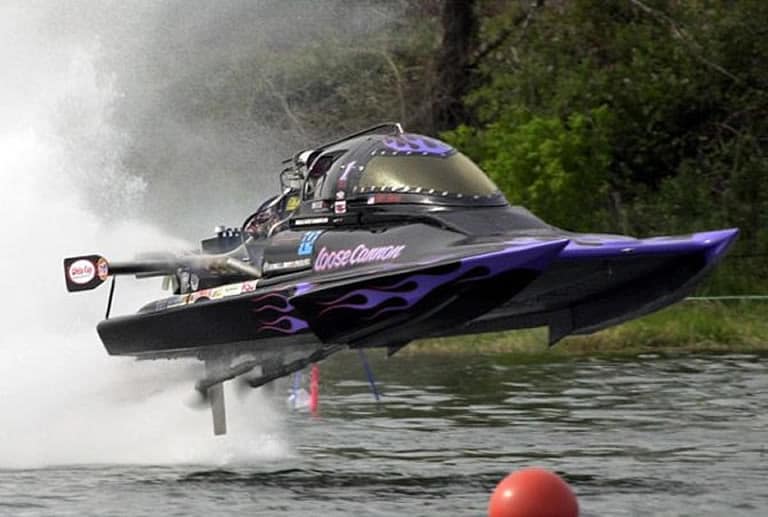Watercraft racing has been around for many years. From canoe sprints to yacht racing, it is undeniable that water races are exciting to watch. But boat races are not limited to slower craft. One racing event that is fast becoming popular is drag boat racing, with drag boats that can reach speeds up to 270 mph.
Contents
What A Drag Boat Is And What Drag Boats Are Used For
You may be wondering what a drag boat is and want to know more about drag boat racing.
So, let’s explore this exciting topic in detail.
We will start by answer the question, “what is a drag boat?”.
A drag boat is a high-speed motorized vessel that is used for water sport racing.
There are three common types of drag boat:
- Top fuel.
- Flat Bottom.
- Jet.
Top fuel drag boats can reach speeds of up to 270 mph, while flat bottom and Jet drag boats can reach speeds of 50 mph.
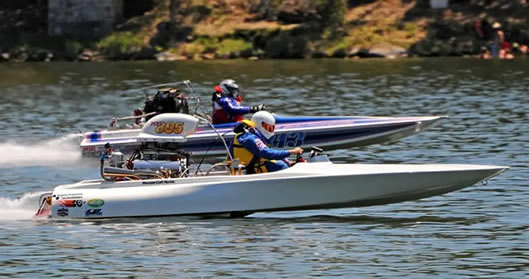
Let us take a closer look at the use, construction, and types of drag boats currently in use.
We will also explore the world of drag boat racing and its mechanics to help you better understand exactly what a drag boat is.
Generally, water vessels are mainly designed to transport people and cargo.
Considered as one of the driving forces behind the globalization of trade and population migration, water transportation has opened up many nations and communities to each other around the globe allowing them to flourish through commerce and trade.
This is not the whole story about the humble boat though.
Throughout the centuries people have found that watercraft are not only good for transportation and the movement of goods but can be great for more fun activities as well.
Over the centuries people have modified, or crafted new, boat designs so they could be utilized for water sports.
In the 21st century one of the best watercraft for motorized racing is the drag boat.
Drag boats are primarily used for high-speed water sport racing.
Many types of competitions currently exist in the world of water sports.
But one distinct fact about drag boat racing is its pace. Drag boats can reach speeds of up to 270 mph or 400 km/h.
Drag boat basics
A typical high-speed drag boat consists of a strong hull, aerodynamic design and a powerful engine for efficient, fast propulsion.
Drag boats can often differ in build and overall structure as racers and owners usually apply their own preference in modifying their boats.
Most observed modifications include adjusting the sharpness of the hull, applying a bigger propeller or putting in a calibrated engine.
The 3 types of drag boat
Now let us take a closer look at the three most common types of drag boats.
The 3 types of drag boat are:
- Hydroplane drag boat (a.k.a. top fuel drag boats).
- Flat bottom drag boat.
- Jet drag boat.
1. Hydroplane – top fuel drag boat
Hydroplane drag boats, also known as a top fuel hydroplanes, or more commonly as top fuel drag boats have a specific shape that usually consists of a three-point hull.
This unique hull design helps lift, or “plane”, the boat in an upward movement.
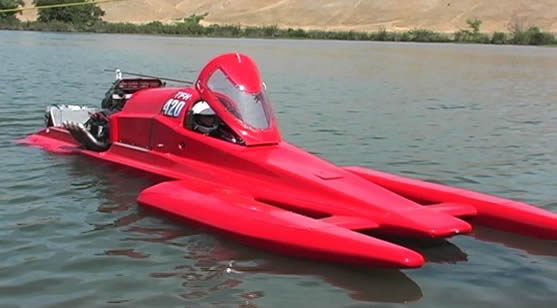
This planning motion is generated by a burst of acceleration that helps lift the boat up to sit “on top of the water” rather than “in the water”.
When the boat gets on plane it encounters less resistance from the water and can therefore reach higher speeds as it “glides” across the water.
Early designs of top fuel drag boats were often constructed by amateurs, who utilized whatever lightweight materials were available to them.
These usually took the form of plywood and timber.
In addition, the concept of planing a top fuel drag boat was not discovered until the early users of hydroplane boats employed the three-point hull design.
A hydroplane is a top choice for drag boat racers because it is considered to be the fastest among the three types of drag boats.
It has the term “top fuel” attached to its name because it uses Jet-A (kerosene) fuel.
A top fuel drag boat can reach a maximum speed of 270 miles per hour. The fastest drag boat will always be top fuel drag boat.
Top fuel drag boats are considered the fastest accelerating boats in the world.
2. Flat bottom drag boat
In contrast to the Hydroplane drag boat, a flat bottom drag boat can only reach speeds of 50 miles per hour though for watercraft this is still quite fast.
A flat bottom drag boat is similar looking to a typical ski boat.
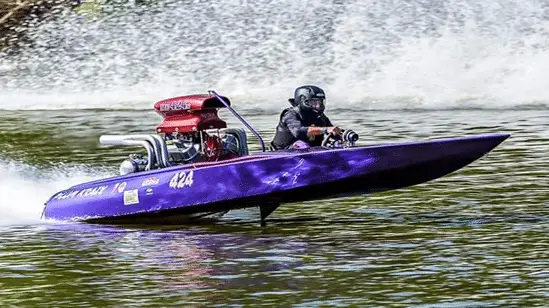
This type of drag boat sports a leveled surface for better stability and high drag.
But to counter the excessive vertical drag, flat bottom boats have a sharp bow.
Most flat bottom drag boats become an average family ski boat after its racing life has ended.
3. Jet drag boat
Like a flat bottom drag boat a Jet drag boat can reach speeds of up to 50 mph.
A jet drag boat can have different hull designs.
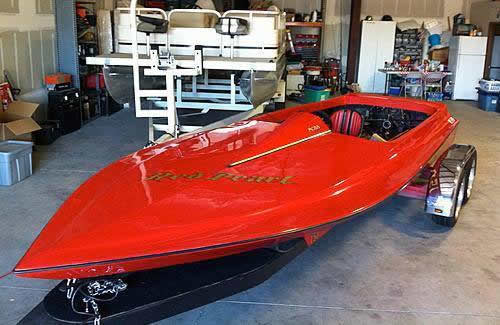
It can sport a one-point, two-point or a three-point hull design.
Rather than the hull design being the main characteristic of a jet drag boat, the key characteristic of this type of racer is its ability to be propelled and steered solely through its jet propulsion system.
The typical cost of a drag boat is more than you think
Owning a drag boat for racing can be pretty expensive.
A top-fuel boat, like a hydroplane drag boat, can cost $200,000.
This cost does not include the kind of additional modifications routinely made to these type of high-end racing boats.
Modifications and upgrades can push up the overall final cost of a high-end hydroplane drag boat to about $1,000,000.
For an average factory-class lower-end drag boat, anywhere from $10,000 to $15,000 is often enough to cover the type of modifications needed to make the boat a potential winner.
Experienced drag boat owners and drivers suggest that one can’t just go out and buy a winning drag boat.
A person interested in drag boats needs to at least research and study the dynamics of the boats and how each differs from the other.
The competition also gets tougher every year as more drag boat manufacturers develop new technologies.
This means that if you are a new buyer, or already an owner of a drag boat, you need to spend more money to keep up with the competition.
If you do want to own one of these water speedsters then you should also factor in the cost of maintenance and repair, which typically costs $1,000+ per year.
For a more in-depth look at the costs associated with buying and running a drag boat read this article.
The typical speed of a drag boat varies between drag boat types
If you watch a drag boat race for the first time, you will notice how short a typical race can last.
Drag boat racing is a different kind of experience from a usual car race on land.
Imagine boats reaching breath-taking speeds in as little as six seconds to complete a quarter-mile drag race.
These super fast races are down to the super efficient and speedy engines on the boats.
A drag boat can be powered by a motor that can clock from 1600 to 4500 horsepower.
The typical speed for a hydroplane drag boat is 270 mph.
A flat bottom and a jet drag boat can each reach speeds of 50 mph.
How do you stop a boat going so fast?
Faster boats have a stronger keel and propeller to help them stop.
Most of the really fast boats also require drogue parachutes for better breaking and for an extra layer of protection against crashes.
Drag Boat Racing 101
Racing events are categorized based on the speed of the participating boats.
There are events for boats with a top speed of 270 mph and ones for boats with top speeds of 50 mph.
Drag boat course layouts and categories of drag boats
Drag boat racing can be seen as similar to land drag racing. Both are based on the fundamentals of speed, acceleration and time.
Obviously, drag boat racing is an activity which takes place on water instead of land.
Commonly, there are three drag race course lengths:
● 1/8 mile or 660 feet.
● 1/4 mile or 1,320 feet.
● 3/16 miles or 1,000 feet.
These course lengths are standard in many race events. However, the categories for races vary at amateur and professional levels.
Drag boats with similar fuel types, engine configurations, and hull designs, as well as propulsion types are classed together for fairer competition.
In addition, while the competition in drag boat racing is high, the overall atmosphere among the racers is typically congenial.
The good-natured friendly atmosphere among the racers also results in good natured friendly interactions with opposing fans thus creating better entertainment for everyone who watches the race.
This makes drag boat racing events very family-friendly.
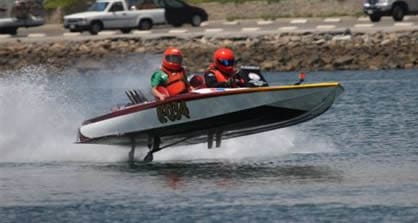
It should be mentioned that the Top Fuel Hydroplane class is the premier category of any drag boat race.
This is equivalent to land-based racing’s Top Fuel Dragsters.
The Top Fuel Hydroplane, with a high speed of 270 miles per hour, can cover a quarter mile in more or less three seconds.
Where drag boat races are held
Drag boat races are typically held in places where the water condition is calm and the weather can be properly predicted.
Lakes are a top choice as they offer relatively calmer water for drag boat drivers and race organizers.
Drag boat racing events are more common in the United States of America where they are extremely popular.
Top training race equipment and technologies are also more prevalent in the USA.
Although once popular in Canada drag boat races have been in decline there since the 1980’s.
A great example of a big drag boat race event is the SDBA Race in Lake Lucas, Wheatland, Missouri.
Drag boat racer wages are higher than you may imagine
How much does a drag boat racer earn?
A drag boat racer will earn an average of $83,332.00 per year.
Drag boat safety regulations are strictly monitored
The safety of drag boat drivers is always important, whether in competition or training activities, and is strictly monitored.
All boats, motors, and equipment receive technical inspection regularly, and these measures are heightened before racing events.
When inspecting a drag boat, technicians look for even slight damage in the hull and engine.
This is especially important because these two are the most critical parts of the boat and damage can lead to accidents.
Top fuel hydro drag boat race (video)
Recap: What A Drag Boat Is & How Drag Boats Are Used
A drag boat is a type of sport watercraft capable of reaching speeds of 270 miles per hour.
This type of boat can be classified into three kinds, namely:
• Hydroplane
• Flat bottom
• Jet.
Hydroplane is the fastest among the three and is used in premier events.
The top speed for a hydroplane drag boat is 270 mph.
A flat bottom and a jet drag boat can each reach a top speed of 50 mph.
Racing events are held in calm water and under calm weather conditions for safety reasons and are most popular in the USA.
If you are interested in owning a drag boat, be ready to shell out $10,000 for a factory-class drag boat or $200,000 for a top-tier one.
If you want to race professionally then be prepared to increase the cost of the boat. Purchase cost and modifications of a high-end drag boat can amount to as much as $1 million dollars.

